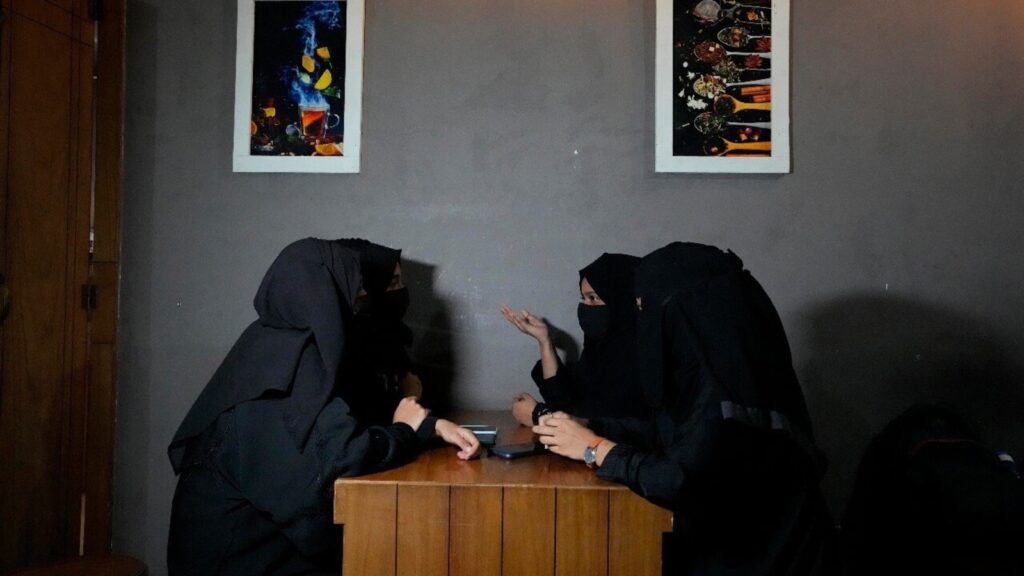Tajikistan, a Central Asian country neighbouring Afghanistan, will ban its citizens from wearing the hijab after the country’s parliament’s upper house, the Majlis-e-Mili, passed a law on June 19 banning “foreign clothing” and children from celebrating Eid al-Fitr and Eid al-Adha, two major Islamic holidays.
The women’s clothing was brought to Tajikistan from the Middle East in recent years and authorities believe it may be linked to Islamic extremism. (AP/File)
On June 19, the 18th Majlis-i-Mili Conference was held under the leadership of Chairman Rustam Emomali.
The bill was passed by the lower house of parliament, Majlis Namoyandagon, on May 8 and focuses primarily on banning the hijab and other traditional Islamic clothing.
What is that law?
According to Radio Ozodi, the Tajik-language station of Radio Liberty, the head of the religious committee, Sulaiman Davlatsoda, said the ban on children’s holidays was in order to “ensure a proper education and safety during Ramadan and Eid al-Adha.”
During the session, they supported amendments to Tajikistan’s legislation on holidays, cultural practices, the role of teachers in children’s upbringing and parental duties, according to the Majlisi Miri news center.
The bill, which bans women’s clothing imported into Tajikistan from the Middle East in recent years and which authorities say has links to Islamic extremism, is controversial in the tightly-ruled former Soviet republic, where most of the population is Muslim.
What is the punishment?
Lawmakers also agreed to new rules for breaking the law, including heavy fines for violators, which previously did not list the wearing of the hijab or other religious clothing as something citizens should not do.
Radio Ozodi reported on May 23 that Tajik authorities have decided to impose different fines on different groups for those who violate these rules.
Individuals can be fined up to 7,920 somoni and companies up to 39,500 somoni. Government officials and religious leaders can face higher fines if convicted: government officials up to 54,000 somoni and religious leaders up to 57,600 somoni.
Has Tajikistan already unofficially banned the hijab?
Tajikistan has officially banned the Islamic hijab after years of informal restrictions. The Tajik government began cracking down on the hijab in 2007, when the Ministry of Education banned both Islamic dress and Western-style miniskirts for students.
The ban was later extended to all public institutions, with some organizations requiring employees and visitors to remove the headscarf. Local authorities formed special teams to enforce the unofficial ban, and police conducted raids in markets to arrest rule-breakers. However, authorities have denied multiple reports from women who claim they were stopped and fined on the street for wearing the hijab, AsiaPlus reported.
In recent years, the government of Tajikistan has promoted traditional Tajik dress through campaigns. In 2017, millions of people received text messages urging women to wear Tajik national dress. The messages emphasized the importance of respecting these dresses and wearing them as traditions. The effort culminated in 2018 with the release of a 376-page manual titled “Tajikistan’s Recommended Dress Guidebook,” which detailed appropriate attire for various occasions.
Additionally, Tajikistan informally encourages men to refrain from growing full beards, and reports suggest that over the past decade thousands of men have been forcibly stopped by police and had their beards shaved against their will.
Tajikistan’s view on the issue
In March this year, Tajikistan’s President Emomali Rahmon said: “Xenophobia in terms of false names and dress, such as wearing the hijab and foreign clothing, is another pressing issue for our society.”

